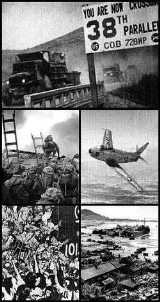
The Korean War was a conventional war between South Korea
, supported by the United Nations
, and North Korea
, supported by the People's Republic of China
(PRC), with military material aid from the Soviet Union
. The war was a result of the physical division of Korea
by an agreement of the victorious Allies
at the conclusion of the Pacific War
at the end of World War II
. The Korean peninsula
was ruled by Japan
from 1910 until the end of World War II. Following the surrender of Japan
in 1945, American administrators divided the peninsula along the 38th Parallel
, with United States troops occupying the southern part and Soviet troops occupying the northern part.
The failure to hold free elections throughout the Korean Peninsula in 1948 deepened the division between the two sides, and the North established a Communist government.
1950 The Korean War begins with the invasion of South Korea by North Korea.
1950 The United States decides to send troops to fight in the Korean War.
1950 Korean War: Korean War: Korean War: [[Task Force Smith
1950 Korean War: North Korean troops initiate the Battle of Taejon.
1950 Korean War: United States forces land at Inchon
1950 Korean War: The First Battle of Maryang San, primarily pitting Australian and British forces against communist China, begins.
1950 Korean War: After the Chinese leadership finally settled the issue of armed intervention on October 18, the People's Republic of China joins the Korean War by sending thousands of troops across the Yalu river to fight United Nations forces.
1950 Korean War: After the Chinese leadership finally settled the issue of armed intervention on October 18, the People's Republic of China joins the Korean War by sending thousands of troops across the Yalu river to fight United Nations forces.
1950 Korean War: United States Air Force Lt. Russell J. Brown shoots down two North Korean MiG-15s in the first jet aircraft-to-jet aircraft dogfight in history.
1950 Korean War: Troops from the People's Republic of China launch a massive counterattack in North Korea against South Korean and United Nations forces (the Battle of the Ch'ongch'on River and the Battle of Chosin Reservoir), ending any hopes of a quick end to the conflict.

